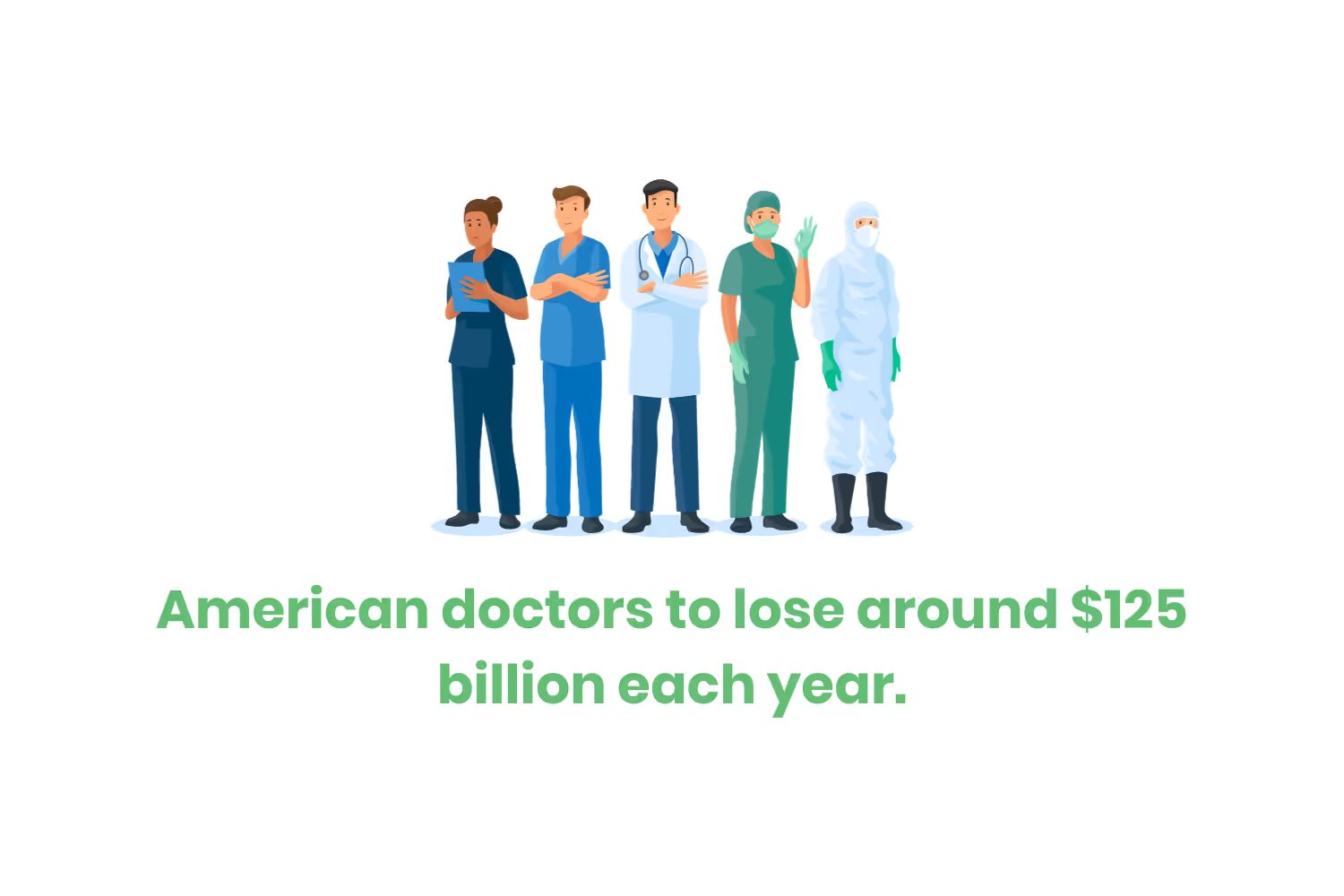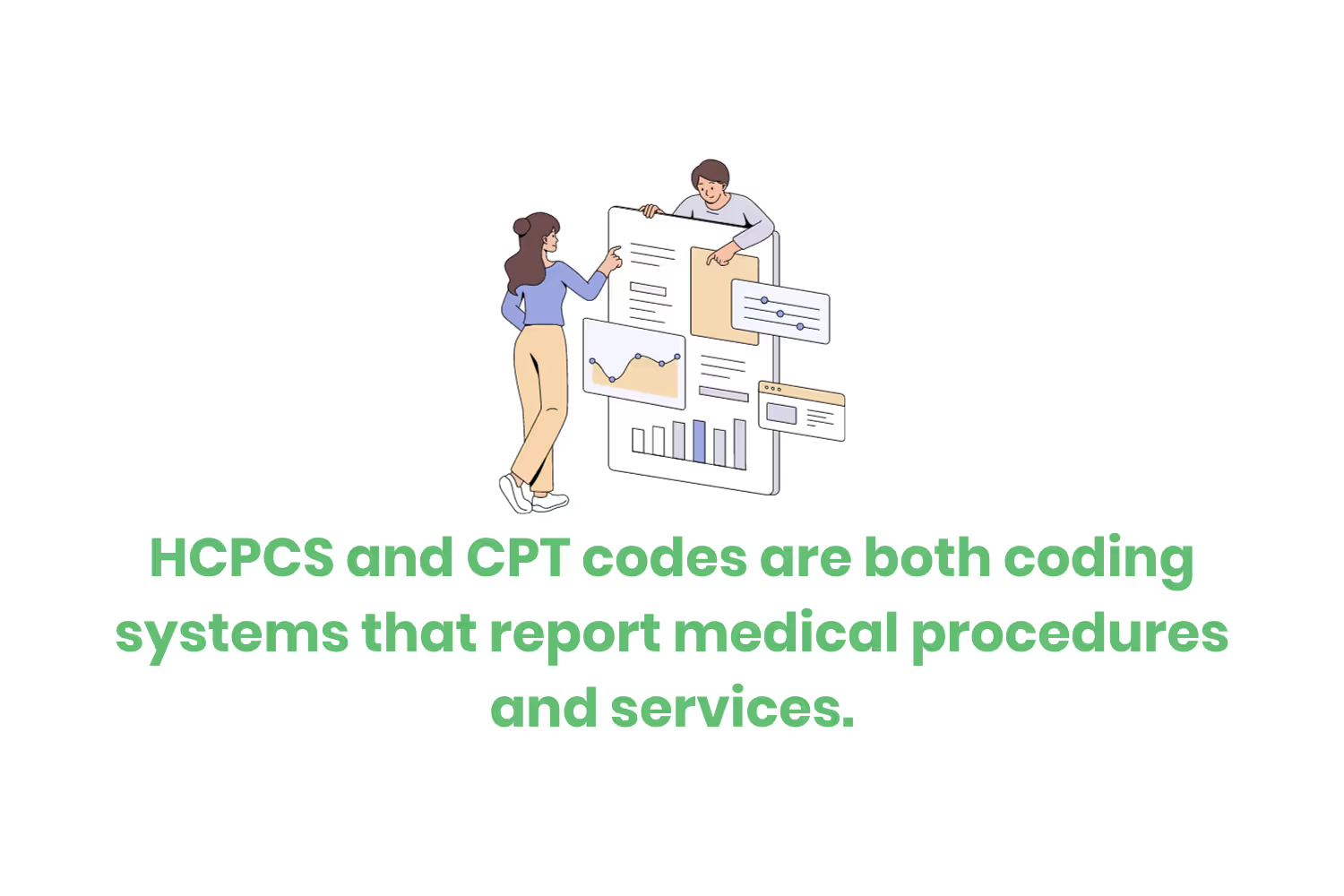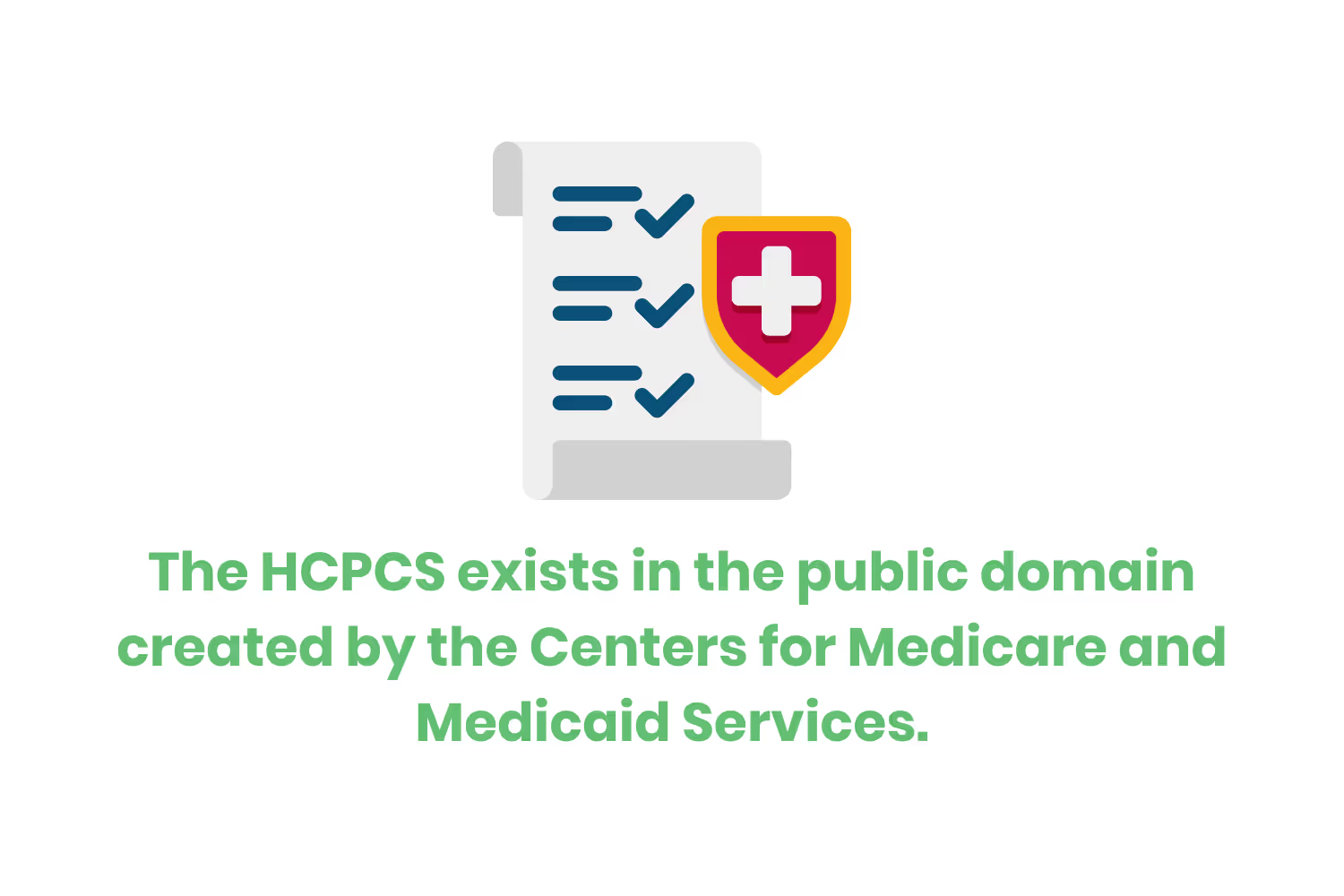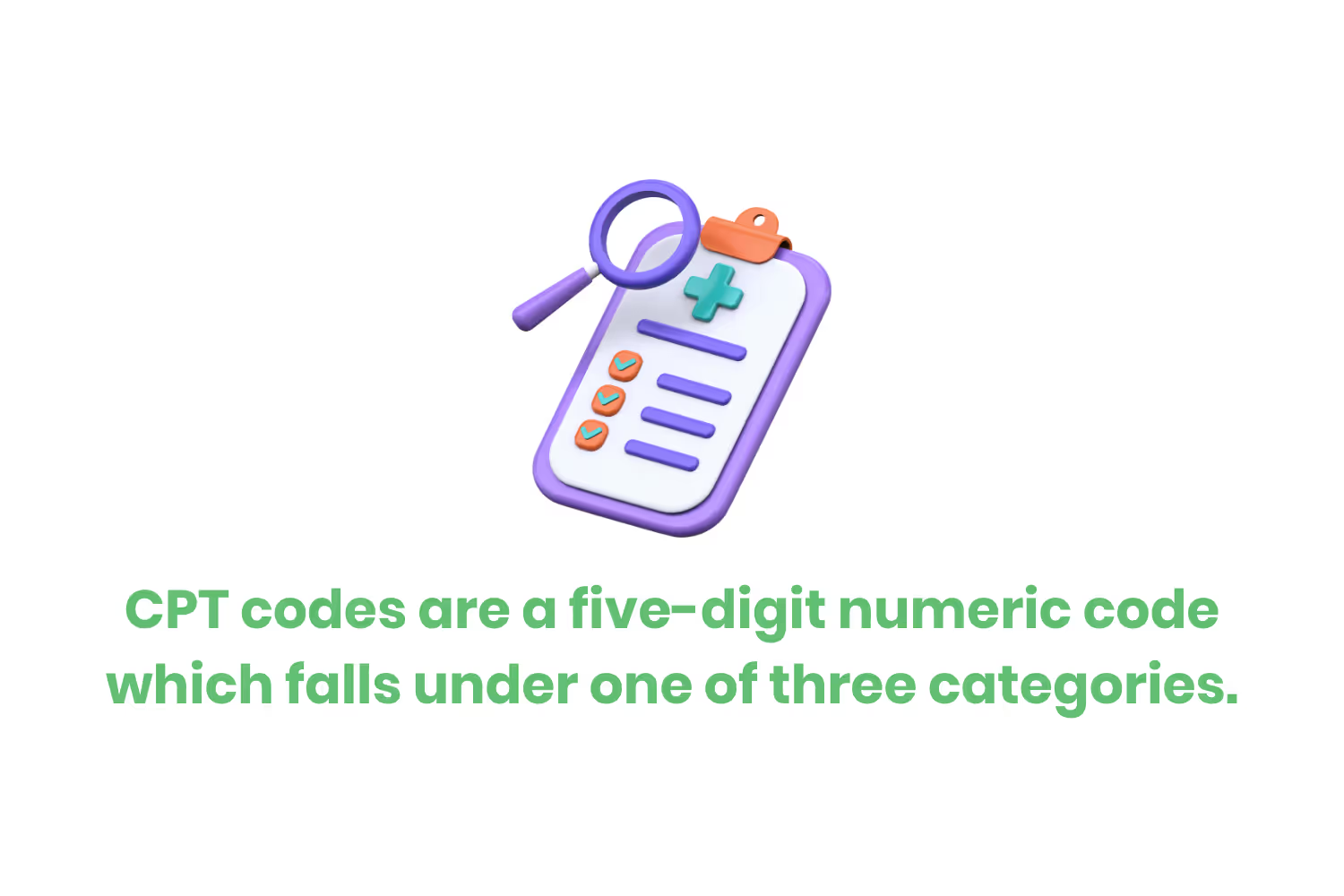HCPCS vs CPT: Understanding the Healthcare Common Procedure Coding System
Let’s look at the differences between HCPCS and CPT codes, why they are important, and why you should know the difference.

Did you know that poor billing practices cause American doctors to lose around $125 billion each year?
Medical billing and coding has many challenges. If you keep up with our blogs or work in the industry, you know exactly what I’m talking about.
Even if you’re new here, or just getting started in your career, the American healthcare system should speak for itself - nothing about it is straightforward.
So why would it be any easier on the backend?

Don’t panic! We are here to help you avoid unnecessary billing and coding mistakes so you can collect your revenue promptly. Avoid putting stress on your billing team by preparing for the more common mistakes. Preventing denial codes is essential if you want to keep a steady revenue flow.
For example, two terms are commonly misunderstood by billing professionals. By misunderstood, I mean people usually confuse them with one another. This is an easily preventable billing error, which we are going to go over in this blog. HCPCS (Healthcare Common Procedure Coding System) and CPT® codes (Current Procedural Terminology) are similar in function, but with important differences which dictate their usage.
These two coding systems both handle medical procedures and services. However, HCPCS codes are used to classify those procedures and services, while CPT codes describe them. Let’s look at the differences between both codes, why they are important, and why you should know the difference.
What are the Key Differences Between HCPCS and CPT Codes?
HCPCS and CPT codes are both coding systems that report medical procedures and a variety of services. Used frequently in the medical and billing industry, it is important to fully understand the differences between the two. This is especially true when considering revenue cycle management and claim denial percentages. The main difference between these codes lies in their:
- Purpose.
- Structure.
- Usage.
Developed and maintained by the American Medical Association (AMA), CPT codes describe and report medical, surgical, and diagnostic procedures/services for billing purposes. However, Medicare and other insurance cover a variety of different services and supplies, some of which aren’t identified by CPT codes.

This is why we have HCPCS codes. This is the other main set of procedure codes that classify medical services. Note that HCPCS draws from the AMA’s Current Procedural Terminology (CPT). These codes assist healthcare workers in reporting different medical procedures and services to health insurance programs, such as Medicare and Medicaid.
However, there are different levels to the HCPCS, which offer various degrees of coverage that CPT-4 (Edition 4) does not. HCPCS is divided into two distinct levels. For a better grasp of things, let’s go over the structures for each code.
Healthcare Common Procedure Coding System Code Structure
The HCPCS exists in the public domain created by the Centers for Medicare and Medicaid Services. These codes are alphanumeric and fall into two principal subsystems: Level I and Level II. Level I consists of Current Procedural Terminology (CPT-4), while Level II identifies products, supplies, and services not covered by CPT-4 codes. Note that HCPCS Level II codes are also maintained by the Centers for Medicare and Medicaid Services.
HCPCS Level I codes report services and procedures performed to payers by physicians, non-physician practitioners, hospitals, laboratories, and outpatient facilities. Level II is the national procedure code set for healthcare practitioners, providers, and medical equipment suppliers used primarily to identify products, supplies, and other services not covered by CPT-4 codes. These include:
- Ambulatory services.
- Durable medical equipment.
- Prosthetics.
- Orthotics.
- Supplies (DMEPOS) when used outside of a physician’s office.

HCPCS Level II codes consist of one alphabetical letter followed by four numbers. Which the CMS maintains. Check out our list of the different meanings for the following alphabetical letters you can find in a level II HCPCS code:
- A Codes - Transportation, medical supplies, surgical supplies, misc and experimental.
- B Codes - Enteral and parenteral therapy.
- C Codes - Temporary outpatient hospital prospective payment system.
- D Codes - Dental procedures.
- E Codes - Durable medical equipment.
- G Codes - Professional services and temporary procedures.
- H Codes - Rehabilitative services.
- J Codes - Drugs administered (other than oral methods and chemotherapy drugs).
- K Codes - Temporary codes for durable medical equipment regional carriers.
- L Codes - Prosthetic or orthotic procedures.
- M Codes - Medical services.
- P Codes - Pathology and laboratory.
- Q Codes - Temporary codes.
- R Codes - Diagnostic radiology.
- S Codes - Private payer codes.
- T Codes - State Medical agency codes.
- V Codes - Vision and hearing.
There was a Level III to report medical services and procedures, although this was discontinued in 2003 and is no longer accepted.
HCPCS Examples
Here are a few examples of some popular HCPCS alpha-numeric codes and their meanings:
- E0260 - Use of a semi-electric hospital bed as part of treatment.
- A9270 - Use if a service is not covered by Medicare or Medicaid. There is no equivalent CPT code as CPT does not include provisions for non-covered service.
- A0425 - Ambulance transportation (ground mileage).
- G9631 - Ureter injury during time of surgery or discovered up to 30 days post-surgery.
- V2599 - Contact lens, other type.
- R0070 - The transportation of personnel and portable X-ray equipment to nursing homes or other residency. For multiple patients, use code R0075.
Current Procedural Terminology Standardized Coding System
We already went into what CPT stands for and why we need this medical code set, but I’ll go over it again just for a quick review. Current Procedural Terminology (CPT) is a medical coding system that healthcare professionals use to report the following procedures and services:
- Medical.
- Surgical.
- Diagnostic.

The system is an essential tool in any medical biller’s toolbelt, as it serves as a uniform language for communicating information about these procedures and services in a healthcare setting. CPT codes are a five-digit numeric code which falls under one of three categories. The categories are as follows:
- Category I: The most commonly used CPT codes. These codes describe most basic healthcare services and procedures. There are six subcategories of this category, which are:
- Evaluation and Management.
- Anesthesia.
- Surgery.
- Radiology.
- Pathology.
- Laboratory.
- Medicine.
- Category II: This category contains optional performance measurement codes. These codes provide data about the quality of care given. This category is helpful for data collection, measurement, and analysis.
- Category III: These are temporary codes. They are for emerging and experimental practices. These codes allow for data collection on new services, procedures, and technologies to substantiate widespread usage.
CPT Examples
Here are a few examples of some popular CPT codes and their meanings:
- 99214 - Office visit.
- 99397 - Preventive exam (over the age 65).
- 90658 - Administration of a flu shot.
- 99213 - Office or other outpatient visit to evaluate and manage an established patient.
- 20610 - Aspiration and/or injection of a large joint or joint capsule.
- 71020 - Chest X-ray.
Why You Need to Know the Difference Between HCPCS and CPT
Understanding the difference between HCPCS codes and the CPT system is essential in more ways than one. This is true, especially in the world of medical billing. The financial health of your healthcare organization falls in the hands of those who work with your patient invoices. With accuracy, comes a faster turnaround and a lower percentage of claim denials. Here are some other ways having your team familiar with these codes can help your practice.
Accurate Billing and Reimbursement
I mentioned financial wellness already, but I would bet that is every business’s number one priority, so let’s dive deeper into the subject. Being able to accurately and confidently code for a wide range of services means your billing team is less likely to have issues with underpayment or overpayment of invoices. From medical procedures to equipment, each corresponding code ensures that healthcare providers are accurately reimbursed for their services.

Efficient Communication
Utilizing these codes properly strengthens the standardized language for documenting and communicating medical services. Understanding the differences between HCPCS and CPT codes facilitates this communication between healthcare providers, insurance companies, and patients. With better communication practices come lower chances of denied or delayed claim submissions. Therefore, faster reimbursement!
Data Analysis and Research
Using HCPCS and CPT codes correctly also helps medical researchers collect public health data. These codes function as essential tools which help to identify trends in healthcare services. They also assist in tracking the prevalence of specific procedures as well as studying the cost of healthcare across the country. Data gathered from this can help inform policy decisions as well as contribute to the bettering of the healthcare industry.
Regulatory Compliance
All organizations that work with protected health information (PHI) must comply with the Health Insurance Portability and Accountability Act (HIPAA). Using HCPCS and CPT codes enables organizations to safely communicate this PHI within the company and to other covered entities.
HIPAA’s billing and coding standards require the use of both sets of codes for all electronic healthcare transactions. Non-compliance can lead to issues with collecting your revenue and even worse potential legal consequences.
Common Billing Errors Related to HCPCS Codes and CPT Codes
No matter how familiar healthcare professionals are with billing codes, they can still make mistakes while using CPT and HCPCS codes. These mistakes then lead to larger problems such as claim denials, reimbursement delays, and compliance risks. Understanding the difference between these products and services codes is key to keeping your revenue cycle flowing. Here are a few common billing mistakes to look out for when handling these codes, and the best ways to prevent them!
Using the Wrong Level of HCPCS Codes
Sounds simple enough, but don't let your guard down. Mixing up HCPCS coding levels can result in a claim denial and outstanding payments. It could be a silly mistake, but an easy one to make. You want to make sure you always double check if you aren't sure which code goes where. Tip: if you are really stumped, check if the service is under a CPT code umbrella instead of a specific HCPCS code to bill it.
Confusing CPT and HCPCS Code Sets
Both of these coding systems serve different purposes, even if they both report healthcare services and procedures. Some people may still mix these up. Use the official CMS-maintained resources to avoid these mistakes. This can help you better determine whether you should use these codes to bill a procedure under HCPCS or CPT.
Using Expired or Incorrect Code Sets
Staying up to date with the most recent CPT coding systems and HCPCS code sets is crucial. After all, these codes are prone to undergoing regular updates. The use of outdated codes can lead to rejected claims as well as revenue loss. Keep in mind that the AMA CPT Editorial Panel updates CPT codes annually. While CMS updates HCPCS codes quarterly. Stay up to date with these medical code set changes by subscribing to newsletters and checking different codes used regularly.
Not Applying the Right Modifiers
The use of modifiers when applying these codes is often the difference between an accepted or a rejected claim. They are handy to help specify services details for private health insurance review. Missing these can result in claim denials and confusion. Remember that HCPCS codes are alphanumeric and these need the correct modifier placement to comply with billing requirements.
Conclusion: HCPCS vs CPT Codes
Knowing the difference between HCPCS and CPT codes is essential if you work in the healthcare industry. By understanding these codes, billing staff can help to ensure the most accurate of billing practices . With an accurate billowing practice, you can expect to see better communication within your organization, more timely reimbursement, and compliance with regulations.
Remember, CPT codes cover most medical procedures and services covered by insurance. HCPCS codes report medical supplies, equipment, and services that aren’t included in CPT codes. Billing private health insurance programs doesn't have to be a pain. Understanding how each code works with the other will help you continue to collect your claims and keep your revenue cycle healthy.
Emphasize your product's unique features or benefits to differentiate it from competitors
In nec dictum adipiscing pharetra enim etiam scelerisque dolor purus ipsum egestas cursus vulputate arcu egestas ut eu sed mollis consectetur mattis pharetra curabitur et maecenas in mattis fames consectetur ipsum quis risus mauris aliquam ornare nisl purus at ipsum nulla accumsan consectetur vestibulum suspendisse aliquam condimentum scelerisque lacinia pellentesque vestibulum condimentum turpis ligula pharetra dictum sapien facilisis sapien at sagittis et cursus congue.
- Pharetra curabitur et maecenas in mattis fames consectetur ipsum quis risus.
- Justo urna nisi auctor consequat consectetur dolor lectus blandit.
- Eget egestas volutpat lacinia vestibulum vitae mattis hendrerit.
- Ornare elit odio tellus orci bibendum dictum id sem congue enim amet diam.
Incorporate statistics or specific numbers to highlight the effectiveness or popularity of your offering
Convallis pellentesque ullamcorper sapien sed tristique fermentum proin amet quam tincidunt feugiat vitae neque quisque odio ut pellentesque ac mauris eget lectus. Pretium arcu turpis lacus sapien sit at eu sapien duis magna nunc nibh nam non ut nibh ultrices ultrices elementum egestas enim nisl sed cursus pellentesque sit dignissim enim euismod sit et convallis sed pelis viverra quam at nisl sit pharetra enim nisl nec vestibulum posuere in volutpat sed blandit neque risus.

Use time-sensitive language to encourage immediate action, such as "Limited Time Offer
Feugiat vitae neque quisque odio ut pellentesque ac mauris eget lectus. Pretium arcu turpis lacus sapien sit at eu sapien duis magna nunc nibh nam non ut nibh ultrices ultrices elementum egestas enim nisl sed cursus pellentesque sit dignissim enim euismod sit et convallis sed pelis viverra quam at nisl sit pharetra enim nisl nec vestibulum posuere in volutpat sed blandit neque risus.
- Pharetra curabitur et maecenas in mattis fames consectetur ipsum quis risus.
- Justo urna nisi auctor consequat consectetur dolor lectus blandit.
- Eget egestas volutpat lacinia vestibulum vitae mattis hendrerit.
- Ornare elit odio tellus orci bibendum dictum id sem congue enim amet diam.
Address customer pain points directly by showing how your product solves their problems
Feugiat vitae neque quisque odio ut pellentesque ac mauris eget lectus. Pretium arcu turpis lacus sapien sit at eu sapien duis magna nunc nibh nam non ut nibh ultrices ultrices elementum egestas enim nisl sed cursus pellentesque sit dignissim enim euismod sit et convallis sed pelis viverra quam at nisl sit pharetra enim nisl nec vestibulum posuere in volutpat sed blandit neque risus.
Vel etiam vel amet aenean eget in habitasse nunc duis tellus sem turpis risus aliquam ac volutpat tellus eu faucibus ullamcorper.
Tailor titles to your ideal customer segment using phrases like "Designed for Busy Professionals
Sed pretium id nibh id sit felis vitae volutpat volutpat adipiscing at sodales neque lectus mi phasellus commodo at elit suspendisse ornare faucibus lectus purus viverra in nec aliquet commodo et sed sed nisi tempor mi pellentesque arcu viverra pretium duis enim vulputate dignissim etiam ultrices vitae neque urna proin nibh diam turpis augue lacus.




